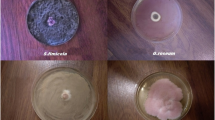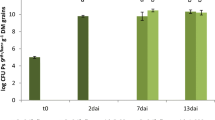Abstract
The objective of the present study was to determine the effect on infection of wheat spikes by toxigenic fungi (Aspergillus parasiticus NRRL 2999, Fusarium tricinctum NRRL 3299, Fusarium graminearum CEREMIC 136/92) and a strain of Streptomyces sp. that is antagonistic to the above-mentioned fungi. Wheat grains (variety GRANERO INTA) were sown in 8 pots containing natural soil and kept in a greenhouse chamber. In the period of the early anthesis the wheat spikes were inoculated with conidial suspensions of each of the fungi in the presence or absence of Streptomyces. Each pot was assigned a different treatment. After an incubation of 100 days and when the wheat plants had attained maturity, the spikes were separated and the following items were determined: (a) number of grains obtained with each treatment, (b) weight of the grains, (c) average weight of the grains/treatment, (d) average number and weight of the grains/spike, and (e) invasion of the caryopses by the microorganisms determined by the analysis of the caryopses in seriate histological sections.
There was a significant decrease (p<0.01) in the average weight of the caryopses and in the weight and number of grains/spike in the presence F. graminearum. The wheat grains were invaded by of F. graminearum and A. parasiticus, an effect which was partially attenuated by the presence of antagonist Streptomyces sp. Nevertheless, the effect was not strong enough to prevent the degenerative consequences on the size and weight of the grains produced by F. graminearum.
Similar content being viewed by others
References
Chelkowski J (ed.). Cereal grain. Mycotoxins, fungi and quality in drying and storage. Amsterdam: Elsevier, 1991.
Christensen CM, Kaufmann HH (eds.). Grain storage: The role of fungi on qualify loss. Minneapolis: University of Minnesota Press, 1969.
Hudson HJ (ed.). Fungal Biology. London: Edward Arnold, 1986.
Taylor AG, Harman GE. Concepts and technologies of selected seed treatments. Annu Rev Phytopathol 1990; 28: 321–339.
Mycock DJ, Berjak P. Paradoxical behavior of seed-storage and field fungi: an overview. SAfr J Sci 1992; 88: 371–375.
Steyn PS (ed.). The biosynthesis of mycotoxins (A study in secondary metabolism). New York: Academic Press, 1980.
Smith JE, Moss MC (eds.). Mycotoxins, formation, analysis and significance. London: Wiley, 1985.
Wicklow DT. Aflatoxin and Aspergillus flavus in corn. Taxonomic features and ecological significance of sclerotia. 5th Coop Ser Bull 1983; 279: 6–12.
Cotty PJ. Virulence and cultural characteristics of two Aspergillus flavus strains pathogenic on cotton. Phytopathology 1989; 79: 808–814.
Kozakiewicz Z. Aspergillus species on stored products. Mycol Pap 1989; 161: 1–188.
Agarwal VK; Sinclair JB (eds.). Principles of seed pathology. Vols. 1–2. Florida: CRC Press, 1987.
Pussey PL. Antibiosis as mode of action in postharvest biological control. In Wilson CL, Chalutz E (eds.), Biological Control of Postharvest Diseases of Fruits and Vegetables, Workshop Proc, Sheperdstown: USDA/ARS-92, WV, 1991: 127–134.
Goodfellow M, Williams SS. Ecology of actinomycetes. Annu Rev Microbiol 1983; 37: 189–216.
Gupta RC, Tandon RN. Growth inhibition of fungi by volatiles from Streptomyces. Trans Brit Mycol Soc 1977; 68: 438–439.
Huang HC. Ecological bases of biological control of soilborne plant pathogens. Can J Plant Pathol 1992; 14: 86–91.
Borghi AL, Fulgueira CL, Bracalenti BJC de. Inhibición de Fusarium graminearum por una cepa de Streptomyces sp. Bol Micológ 1988; 4(1): 237–242.
Fulgueira CL, Borghi AL, Bracalenti BJC de. Inhibición de Aspergillus parasiticus NRRL 2999 por una cepa de Streptomyces sp. Rev Microbiol 1989; 20(2): 215–222.
Borghi AL, Fulgueira CL, Bracalenti BJC de. Antagonism between toxicogenic fungi and a strain of Streptomyces sp. Rev Microbiol 1992; 23(3): 194–198.
Fulgueira CL, Borghi AL, Bracalenti BJC de. Interacción de dos hongos toxicogénicos con una cepa de Streptomyces sp. sobre el desarrolo de plantas de trigo. Bol Micol 1992; 7(1–2): 7–12.
McGinnis MR (ed.). Laboratory Handbook of Medical Mycology. New York Academic Press, 1980: 581.
Kiecana I, Perkowski J, Chelkowski J, Visconti A. Trichothecene mycotoxins in kernels and heat fusariosis susceptibility in winter triticale. Mycotoxin Res 1989; 6: 53–56.
Koczowska I, Packa D. Susceptibility of triticale cultivars to grain fusariosis. Mycotoxin Res 1989; 6: 115–119.
O'Brien TP, McCully ME (eds.). The study of plant structure principles and selected methods. Melbourne (Australia): Termarcarphi Ltd, 1981.
Dizco de Strittmatter C. Modificación de una técnica de coloración de Safranina — Fast Green. Bol Soc Arg Bot 1979; 18(3–4): 121–122.
Esau K (ed.). Anatomía de las plantas con semillas. Buenos Aires: Editorial Hemisferio Sur, 1982.
Fhan A (ed.). Anatomia vegetal. Barcelona: Editorial Pirámide, 1985.
Kendall M, Stuart A (eds.). The Advanced Theory of Statistics. Vol. 3. New York: Charles Griffin, 1976.
Hollander M, Wolfe D (eds.), Nonparametric Statistical Methods. Chichester: Wiley, 1972.
Frisvad JC, Kristensen AB, Filtenborg O. Comparison of method used for surface disinfection of food and feed commodities before mycological analysis. In: King AD, Pitt JI, Beuchat LR, Corry JE (eds.). Methods for the Mycological Examination of Food. New York: Plenum Press, 1986.
Zee SY, O'Brien TP. Studies on the ontogeny of the pigment strand in the caryopsis of wheat. Aust J Biol Sci 1970; 23: 1153–1171.
Zee SY, O'Brien TP. Aleurone transfer cell and other structural features of the spikelet of millet. Aust J Biol Sci 1971; 24: 391–395.
Author information
Authors and Affiliations
Rights and permissions
About this article
Cite this article
Fulgueira, C.L., Borghi, A.L., Gattuso, M.A. et al. Effects of the infection of toxigenic fungi and an antagonistic Streptomyces strain on wheat spikes. Mycopathologia 134, 137–142 (1996). https://doi.org/10.1007/BF00436721
Received:
Accepted:
Issue Date:
DOI: https://doi.org/10.1007/BF00436721




